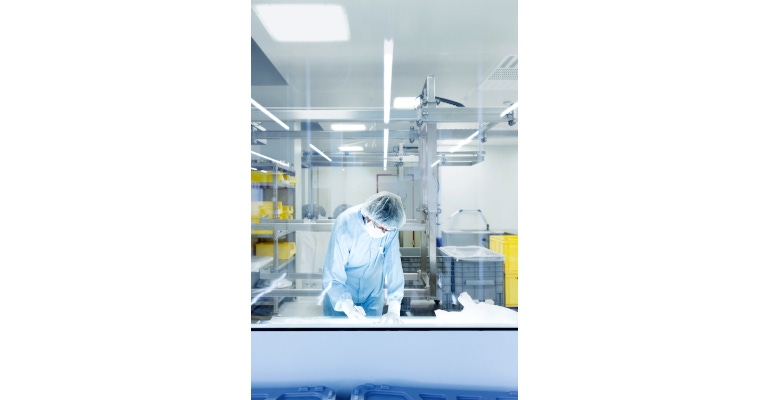Medical therapeutic device manufacturers rely on component suppliers more than ever for best practices and safety.

The single-use device market is primed for growth. Single-use systems (SUS) are now used for about 85 percent of precommercial scale (preclinical and clinical) biopharmaceutical manufacturing and increasingly for commercial products manufacturing. This shift from fixed stainless steel appears to be revolutionizing the therapeutics market.
While large-scale, fixed stainless-steel equipment-based bioprocessing facilities continue producing biopharmaceuticals, the market for SUS, composed primarily of plastic components that are sealed and sterilized using gamma irradiation, continues its rapid ascent. Medical device makers are seeing growth in single-use instruments and disposable medical devices, including process containers, tubing, connectors, baskets, and valves. According to Grand View Research, in 2019, the global SUS market was valued at $12.6 billion, with a 12.8 percent compound annual growth rate forecast through 2027, when it will top $33 billion.
Lower energy and direct-labor costs plus faster changeover times are important reasons why. Like any major change, the SUS shift brings with it challenges as pharmaceutical manufacturers and medical device makers turn to their suppliers to provide assurance that their products deploy operational best practices and are certifiably safe.
Meeting Demands
To address key challenges in the SUS market and meet the product development needs of Tier 1 pharmaceutical and medical device companies, collaboration is seen between Tier 2 system suppliers and Tier 3 components suppliers.
One such effort comes in the form of the BioPhorum Operations Group, a global collaboration comprising more than 90 Tier 1, 2 and 3 biopharmaceutical companies and suppliers; its purpose is to develop and share best practices for pharmaceutical and medical device manufacturing. For example, BioPhorum has succeeded in establishing effective testing methods for extractables and leachables to help the industry approve SUS for safe and effective use.
To select processing materials that avoid risk, it’s important to understand the chemical nature of extractables, which are compounds emitted from a packaging component, delivery system, or manufacturing surface during aggressive testing; and leachables, which are compounds that migrate into the drug over time from contact with the system componentry and manufacturing surfaces.
To assist suppliers with their evaluation of SUS extractables, the BioPhorum team developed testing protocols based on a set of solvents and immersion times. Adhering to such protocols helps ensure the successful use of SUS for biopharmaceutical manufacturing, though the final responsibility for confirming the safety and efficacy of the therapeutic remains that of the Tier 1 pharmaceutical companies and medical device makers, not their suppliers.
Best Practice Guidelines for Single-Use Systems
Complementing the BioPhorum extractables protocol is a best practice guide for evaluating SUS leachables. BioPhorum protocol applies to SUS components that contact the pharmaceutical product or process fluids, including but not limited to the medical device/drug delivery market:
Tubing, tubing connectors, and disconnectors
Bags and films used for storage or mixing, or as bioreactors
Aseptic connectors and disconnectors
Sterilizing-grade and process filters
Tangential flow filtration cassettes
Sensors
Valves
Elastomeric parts (gaskets, O-rings, diaphragms, and septum)
Wetted polymeric surfaces of positive displacement pumps
Chromatography columns
Molded parts of mixers, such as impellers
Filling needles
Note: The standardized extractables testing protocol does not cover final container closure systems.
Making the Grade
Achieving medical-grade system components requires treating the part as a medical product when it comes to cleanroom and manufacturing practices. For tubing, for example, it’s no longer acceptable to manufacture medical-device-grade tubing on the production floor and then attempt to sterilize it. Tubing production for any medical device must take place in ISO certified cleanrooms that adhere to FDA's Current Good Manufacturing Practices governing particulates, air pressure, and personnel practices to ensure that products meet tolerance and cleanliness requirements. This may require bioburden and endotoxin testing.
These procedures help ensure production of safe, validated products in critical areas such as the transfer of monoclonal antibodies, laboratory-produced base media for therapeutics engineered to represent the body’s immune’s system and used in the development of cancer-treating therapeutics. The tubing must be bacteria-free and remain strong as it transfers the monoclonal antibodies to the bioreactor and chromatography equipment, where wanted therapeutics are filtered out.
Other single-use tubing applications include peristaltic pumps with rotating wheels that push the fluid through tubes. To withstand the rigors of the pumping process and ensure that the tubing walls remain intact, high-strength tubing is required.
Looking Ahead
Advancements in therapeutics will continue driving the development and growth of SUS and their components. One such advancement—chimeric antigen receptor (CAR T) cell therapy under development by Kite, a Gilead Company—taps into the potential of personalized medicine for cancer treatments, using the patient’s immune system to target and attack tumors.
T-cells, a white blood cell developed from stem cells in the bone marrow, help the body to fight cancer and infections. Currently, three FDA-approved CAR T cell therapies, developed by Gilead and Novartis, are available. There is also exponential growth of other biotechnology and pharmaceutical companies actively advancing cellular immunotherapies through clinical trials.
Investigational for now, the safety and efficacy of T-cell therapy is an active area of research, and it could prove to be a game-changer. A cancer patient’s blood is collected and purified to select the T-cells, which are activated and expanded within the lab and transfected to express a chimeric antigen receptor, or synthetic T-cell receptor, targeting a specific tumor antigen. The T-cells grow and expand for two weeks and are then infused back into the patient where the engineered cells attack the tumors. This chain of events requires a precise timeline with all components of the process being sterile and having passed stringent testing for quality and reliability.
Unlocking the immune system to effectively fight cancer is truly exciting and serves as a great illustration of the potential medical device use of SUS in biopharmaceutical processing.
About the Author(s)
You May Also Like


